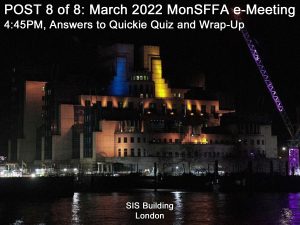 This is Post 8 of 8, marking the official close of today’s virtual meeting. But feel free to continue taking part in our Zoom chat for a while longer, if you wish.
This is Post 8 of 8, marking the official close of today’s virtual meeting. But feel free to continue taking part in our Zoom chat for a while longer, if you wish.
11) ANSWERS TO QUICKIE QUIZ
Here are the answers to the Quickie Quiz we posted at the outset of today’s meeting (see Post 1 of 8). How many titles did you remember correctly?
1) What was the title of that old science fiction show? You know, the one that showed an undulating line at the beginning of each episode and told you there was nothing wrong with your television set, and not to adjust the picture!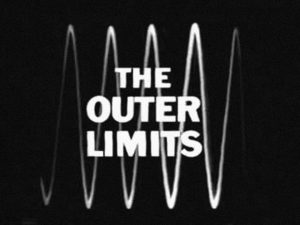
The Outer Limits (1963-1965), an anthology series created by Leslie Stevens and broadcast on the ABC network, often featuring bizarre or frightening aliens and monsters. Eschewing fantasy or the supernatural, the focus of the show was science fiction, and horror writer Stephen King has described Outer Limits as “the best program of its type ever to run on network TV.”
Revived under the same title in 1995, this second version ran for seven seasons.
2) What was the title of that X-Files episode? You know, the one where Mulder and Scully are dancing together at a Cher concert in the closing scene.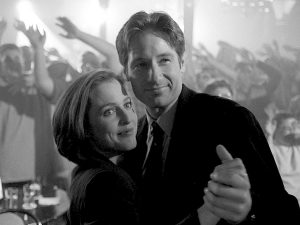
“The Post-Modern Prometheus” (1997), a quirky fifth-season episode written and directed by series creator Chris Carter, who had wanted to pen an episode inspired by Mary Shelley’s seminal SF horror story Frankenstein; or, the Modern Prometheus, and in particular, by James Whale’s 1931 film adaptation of the tale. The episode was filmed in black and white as an homage to the Whale classic.
Cher, an X-Files fan, turned down the offer to cameo in the episode—an imitator was employed in her place. “I wanted them to ask me to come on and act,” she recalled. “They just wanted me to come on and sing.” And the superstar chanteuse wasn’t interested in making such an appearance.
But then she saw the episode! Suitable impressed, she quickly changed her tune, explaining that had she anticipated the exceptional quality of the finished piece, she “would have done it in a heartbeat!”
3) What was the title of that old sci-fi flick? You know, the one where Frankenstein races against Rocky Balboa!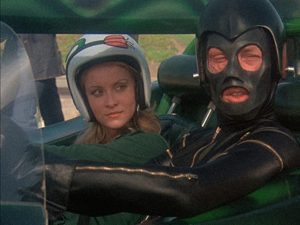
Death Race 2000 (1975) stars David Carradine as a masked race car driver dubbed “Frankenstein,” and features soon-to-be Rocky star Sylvester Stallone in an early role as rival driver “Machine Gun” Joe Viterbo. B-movie impresario Roger Corman is one of the film’s producers.
In the dystopian future of the year 2000, Frankenstein, Machine Gun Joe, and other colourfully named drivers race cross-country in souped-up cars equipped to disable, maim, and kill not only competitors, but hapless pedestrians! Bonus points are scored for hit-and-run deaths!
Sponsored by a totalitarian U.S. government exercising martial law over a land beset by economic collapse and widespread civil unrest, the violent and bloody Transcontinental Road Race is staged annually as a bread-and-circuses distraction for an uneasy populace.
A group of rebels, however, plot against the government and plan to disrupt the race and kidnap champion driver Frankenstein so as to exercise leverage over the regime. But unbeknownst to the rebels, Frankenstein is of kindred thought and has his own plan to assassinate the president and end the carnage.
4) What was the title of that original-series Star Trek episode? You know, the one with the Mugato.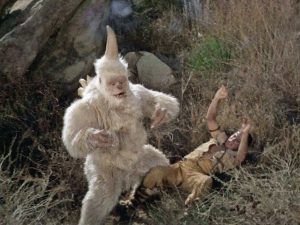
“A Private Little War” (1968), a second-season episode often interpreted as an allegory for U.S. involvement in the Vietnam War.
Gene Roddenberry would ultimately rewrite Don Ingalls’ original script, the first draft of which called the gorilla-like Mugato a Neuralese Great Ape. In later drafts the creature became a Gumato, and is so named in the episode’s closing credits.
5) What was the title of that old creature feature? You know, the one with the giant octopus that pulls down the Golden Gate Bridge!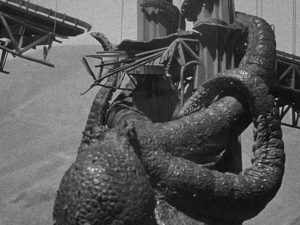
It Came from Beneath the Sea (1955), in which a titanic octopus is displaced from its natural deep-sea habitat by hydrogen bomb tests in the area. The colossal cephalopod terrorizes the Pacific, finally arriving in San Francisco to destroy the Golden Gate Bridge.
The film was a showcase for the stop-motion animation talents of Ray Harryhausen, fresh off the success of his influential 1953 giant-monster movie, The Beast from 20,000 Fathoms. In order to save time and money, Harryhausen’s monster octopus sported only six tentacles, rather that the requisite eight!
It Came from Beneath the Sea marked the beginning of his decades-long association with producer Charles H. Schneer.
6) What was the title of that old Lost in Space episode? You know, the one with the giant talking carrot!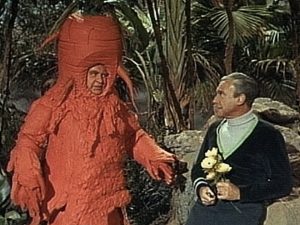
“The Great Vegetable Rebellion” (1968), a third-season episode considered by many SF TV fans as one of the most ridiculous ever produced.
Actor Stanley Adams played Tybo, the famously campy carrot-man and ruler of a planet dominated by intelligent plant life. Trek fans may recognize him as Cyrano Jones, vendor of tribbles!
Writer Peter Packer apologized to series star Jonathan “Dr. Smith” Harris for his story, saying “I didn’t have another damned idea in my head.” He wrote over 20 scripts for Lost in Space; this was his last.
7) What was the title of that old Twilight Zone episode? You know, the one where the Penguin survives a nuclear war, finds piles of books to read in the rubble of the town library, but then accidently shatters his glasses so he can’t read any of them!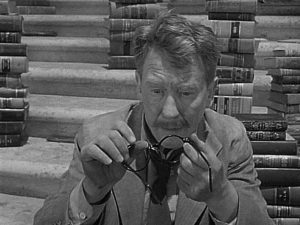
“Time Enough at Last” (1959), an early first-season episode and one of The Twilight Zone’s most celebrated. The teleplay was written by series creator Rod Serling, adapting a short story by Lynn Venable originally published in If: Worlds of Science Fiction.
The episode starred Burgess Meredith in his first of several Twilight Zone appearances. He later played arch villain The Penguin in the popular 1960s Batman TV series.
8) What was the title of that Voyage to the Bottom of the Sea episode? You know, the one where they take aboard Seaview some kind of plankton that keeps growing and growing out of control!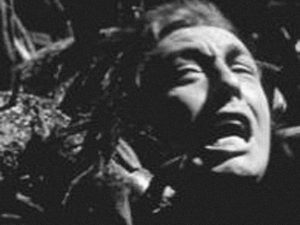
“The Price of Doom” (1964), a first-season episode written by a displeased Harlan Ellison under his pseudonym Cord Wainer Bird.
On top of dealing with the danger to Seaview of this rapidly growing and ever-expanding, bulkhead-buckling plankton, the crew must contend with an enemy agent aboard ship!
9) What was the title of that Star Trek: The Next Generation episode? You know, the one where the aliens speak in metaphors!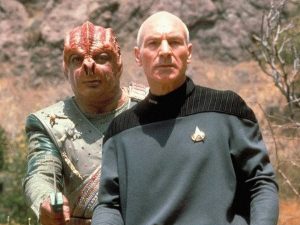
“Darmok” (1991), a fifth-season episode considered one of TNG’s, and indeed, the entire Star Trek franchise’s very best.
The aliens in the episode are called Tamarians and the Federation’s previous attempts to establish relations with them have all failed due to neither side being able to understand the other. The Enterprise is tasked with making contact with a Tamarian vessel in orbit around the planet El-Adrel IV in a fresh attempt. But as the Tamarians communicate their thoughts and emotions through allusions to their history and mythology, Picard and crew are unable to decipher their language any more than the Tamarians are able to comprehend Picard’s entreaties.
The episode’s title refers to the Tamarian phrase “Darmok and Jalad at Tanagra,” which references a Tamarian tale of two warriors who met on the island of Tanagra and united to battle a deadly beast, thus forging a friendship through shared adversity. The orchestrated situation in which Picard soon finds himself with the Tamarian captain, Dathon, on the planet’s surface is similar, and Picard begins to understand how the Tamarians communicate.
When Dathon is wounded battling their shared beastly adversary, Picard tends to his injuries and is eventually able to communicate with Dathon by recounting to him the Epic of Gilgamesh, an Earth legend not unlike the Tamarian captain’s own Darmok and Jalad at Tanagra.
Dathon, unfortunately, succumbs to his wounds and Picard returns to the Enterprise just in time to avoid sparking an unintended war with the Tamarians. Dathon will be remembered by his people as the first to successfully establish communication with the Federation in what they will henceforth term Picard and Dathon at El-Adrel.
10) What was the title of that old dinosaur movie? You know, the one on an island where the guy fights a Tyrannosaurus rex with a mechanical excavator!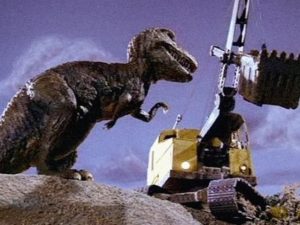
Dinosaurus! (1960), in which a Brontosaurus and a Tyrannosaurus rex, preserved for millions of years in icy suspended animation, are uncovered at the bottom of the harbour bay that a construction crew are dredging on a remote Caribbean island. Pulled up onto the beach, a bolt of lightning during a nighttime storm reanimates the prehistoric titans and they are soon roaming about the island wreaking havoc, culminating in the dinosaur-versus-excavator duel on a cliff side.
The team of producer Jack H. Harris and director Irvin Yeaworth, who had made The Blob two years earlier, offered the lead role to their Blob star, Steve McQueen, but he passed on the opportunity to, instead, appear in a Western, The Magnificent Seven.
Stop-motion and puppetry were employed to bring the dinosaurs to life on screen.
11) What was the title of that original-series Jonny Quest episode? You know, the one with the prehistoric Pteranodon!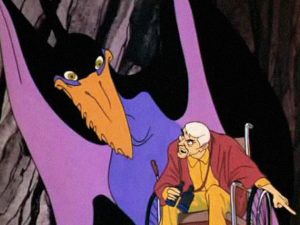
“Turu the Terrible” (1964), in which a wheelchair-bound villain has trained a living Pteranodon called Turu to terrorize and kill. He has tasked the creature with guarding a group of Amazon-jungle natives he has enslaved to mine what he believes to be silver, but which is actually a high-grade deposit of the rare metal, trinoxide. According to Dr. Quest, trinoxide is essential to the space program.
While the natives call the Pteranodon “Turu,” meaning “bird,” the name given the creature by its master is, in fact, “Tulu,” the “L” being a sound the natives cannot properly pronounce. The region in which Turu roams, and trinoxide is to be found, is referred to as “The Land of the Turu.”
The villain and his pet flying reptile meet their end in a tar pit, but Turu lives on, in a manner of speaking, appearing in each episode of the series during the opening-titles montage and closing-credits sequence.
12) What was the title of that Wonder Woman TV episode? You know… The show starred Lynda Carter… It was the episode that introduced Wonder Woman’s younger sister, Wonder Girl!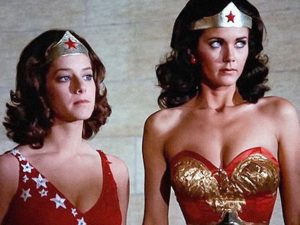
“The Feminum Mystique” (1976), a first-season two-parter, is notable in that it introduces Diana Prince/Wonder Woman’s younger sister, Drusilla, who arrives from Paradise Island to visit Diana in Washington and becomes entangled in a Nazi plot to steal the U.S. Army’s first jet fighter, shortly to be unveiled.
Drusilla assumes the mantle of Wonder Girl and in Part II, helps her big sister thwart a Nazi invasion of Paradise Island in order to compel the Amazons to mine Feminum ore, the metal used to fashion Wonder Woman’s bullet-proof bracelets. Then the two return to Washington to foil the theft of the new jet. All in a day’s work for these two Amazon princesses!
In one of her earliest roles, newcomer Debra Winger played Drusilla/Wonder Girl. The character appeared again later that same season in “Wonder Woman in Hollywood.”
13) I remember this one episode of the Buck Rogers in the 25th Century TV series… There was a spaceship that looked like Montreal’s Olympic Stadium, flipped over! And Catwoman was the villain! What was the title of the thing, again?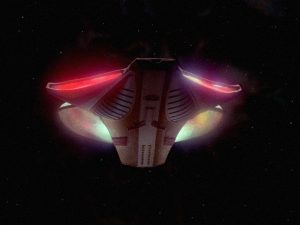
“Flight of the War Witch” (1980), a two-hour adventure, capped the series’ first season and featured Julie “Catwoman” Newmar as the titular War Witch.
Travelling through a mysterious vortex to another universe, Buck and Princess Ardala form an uneasy alliance in order to defeat the pitiless War Witch, Zarina, she the evil Zaad ruler threatening the helpless Pendarans, who have appealed to Buck for help.
Zarina’s flagship is a Zaad Battle Cruiser, the design of which was clearly inspired by Montreal’s Olympic Stadium and Tower, turned upside down!
12) THANK YOU!
We hope you have enjoyed your time with us this afternoon, we thank you for dropping in, and we ask all of you to check in regularly here at www.MonSFFA.ca for additional content during this continuing-but-seemingly-winding-down pandemic, and for any updates as to when the club expects a return to regular, face-to-face meetings. Thank you for your interest and attention, and don’t forget to comment on today’s e-meeting!
We’d like to acknowledge the efforts of Keith Braithwaite and Cathy Palmer-Lister with regard to today’s programming, and thank, as well, all supporting contributors to what has been our March 2022 e-meeting.
13) SIGN-OFF
And so, farewell until we meet again right here at www.MonSFFA.ca on Saturday, April 9, for another in our ongoing series of MonSFFA e-meetings! Peace.
The bracket cards we’ve used this meeting illustrate the show of support expressed by cities around the world for embattled Ukraine.
Slava Ukraini!

